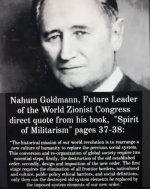The Balfour Declaration (dated 2 November 1917) was a letter from the United Kingdom's Foreign Secretary Arthur James Balfour to Baron Rothschild (Walter Rothschild, 2nd Baron Rothschild), a leader of the British Jewish community, for transmission to the Zionist Federation of Great Britain and Ireland. His Majesty's government view with favour the establishment in Palestine of a national home for the Jewish people, and will use their best endeavours to facilitate the achievement of this object, it being clearly understood that nothing shall be done which may prejudice the civil and religious rights of existing non-Jewish communities in Palestine, or the rights and political status enjoyed by Jews in any other country.

At that time the British were busy making promises. At a War Cabinet meeting, held on 31 October 1917, Balfour suggested that a declaration favorable to Zionist aspirations would allow Great Britain "to carry on extremely useful propaganda both in Russia and America"
The cabinet believed that expressing support would appeal to Jews in Germany and America, and help the war effort.
The "Balfour Declaration" was later incorporated into the Sèvres peace treaty with Turkey and the Mandate for Palestine. The original document is kept at the British Library.
During the first meeting between Weizmann and Balfour in 1906, Balfour asked what Weizmann's objections were to the idea of a Jewish homeland in Uganda, (the
Uganda Protectorate in East Africa in the
British Uganda Programme), rather than in Palestine. According to Weizmann's memoir, the conversation went as follows:
"Mr. Balfour, supposing I was to offer you Paris instead of London, would you take it?" He sat up, looked at me, and answered: "But Dr. Weizmann, we have London." "That is true," I said, "but we had Jerusalem when London was a marsh." He ... said two things which I remember vividly. The first was: "Are there many Jews who think like you?" I answered: "I believe I speak the mind of millions of Jews whom you will never see and who cannot speak for themselves." ... To this he said: "If that is so you will one day be a force."








































